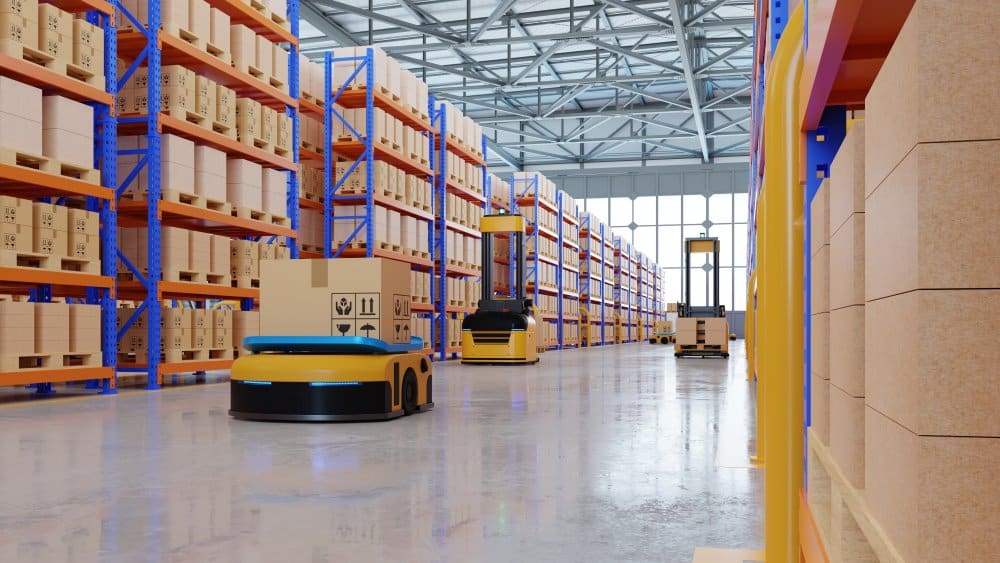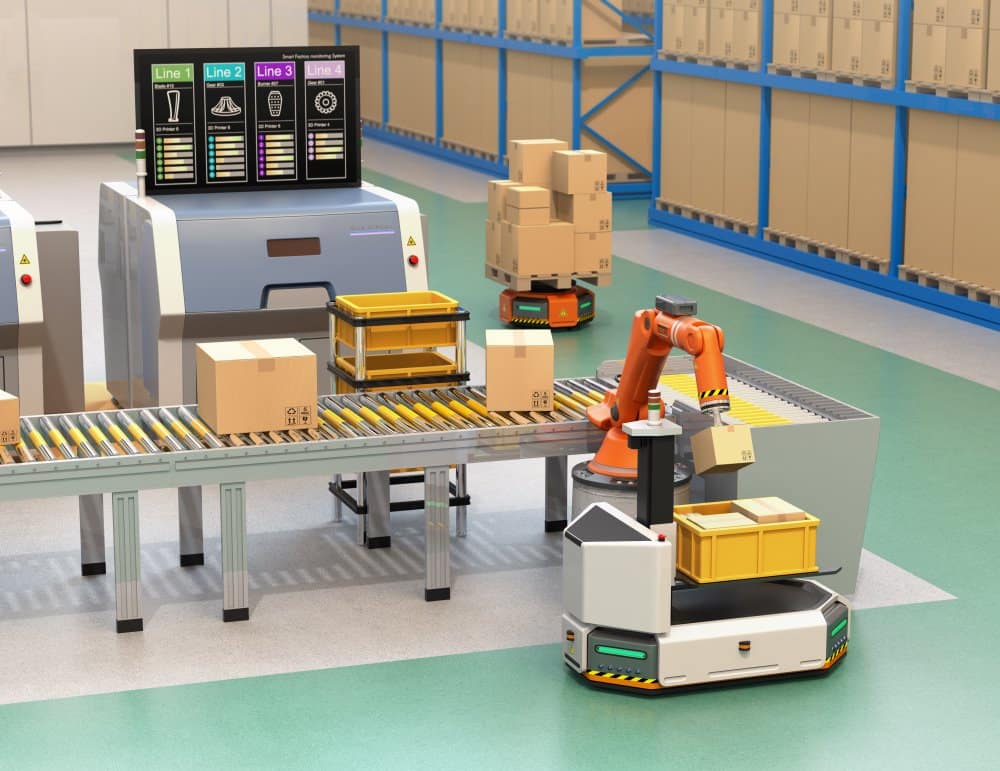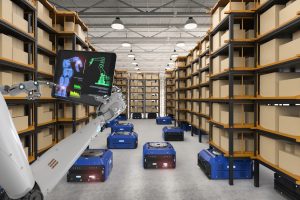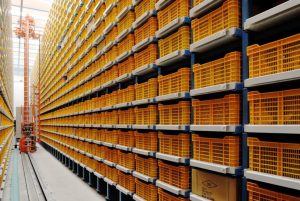In the latest instalment of BoxLogic’s Warehouse Automation series Rob Palin investigates Unmanned Ground Vehicles (UGVs), which include Autonomous Mobile Robots (AMRs) and Automated Guided Vehicles (AGVs) and explains the different types, use cases and benefits in the warehousing and manufacturing environments.

Unmanned Ground Vehicles Introduction
Unmanned Ground Vehicles (UGV) is a collective term for robots that do not need a driver; rather, they are controlled remotely, via sensors or with QR codes. There are two main types of UGVs used in warehousing, AGVs and AMRs. At a basic level, these can replace manual forklift tasks or conveyors, or they can be integrated into full goods-to-person or sorting solutions.
Automated Guided Vehicles (AGVs)
Automated guided vehicles (AGVs) are devices that are used to transport materials, parts, or finished products within a manufacturing or warehouse facility. They are typically guided by a series of QR codes or magnetic floor-taped lines, which allows them to follow a predetermined path without the need for a human operator. Whilst they are excellent at path-following, they lack the sophistication of AMRs and are not able to complete off-track navigation should their path become blocked; they will instead wait for the blocking object to be moved before continuing.
AGVs are often used for moving individual products, pallets or stillages on-top of the robot, but can be configured to tow trains of product on carts behind them. This is particularly useful for moving multiples of products and reducing the number of individual trips, or when the robot is dropping off products at various points along a route.
Single and Multi-Drops
When designing AGV routes around a facility, it is important to consider when to use single drop-off points, and when to use multi drop-off points.
With single drop-offs, an AGV will move between two predetermined points. It will collect product from one location and move to another; repeating this process until it is told to stop. An example of this use case is the movement of picked product to a marshalling location. Product is placed by pickers at the end of a racking aisle. The robot will then collect the product and transport it to a marshalling location. Once the product has been dropped off, the robot will return to the end of aisle racking location and repeat the process.
With multi drop-offs, the robot will stop at multiple predetermined points along a given route. This is particularly useful when delivering to a production line. A robot would pull a train of carts loaded with product along a length of the production line, stopping at each cell allowing operatives to remove their required materials.
Autonomous Mobile Robots (AMRs)
Autonomous mobile robots (AMRs) are mobile robots that are capable of navigating and performing tasks without the need for a human operator. They use sensors, cameras, and advanced algorithms to perceive and navigate their environment, and can be programmed to make decisions and take actions based on real-time data.
Rather than following predetermined tracks like AGVS; AMRs are programmed by scanning the environment they will operate in. Points of Interest (POIs) are marked on the map, such as pickup/drop-off locations, doors, parking areas and no-go zones.
By having a holistic view of their operating space, AMRs can navigate from point to point by creating their own route and work around people. This means that should one route become blocked, the AMR can find the next most efficient route to avoid the blockage. The re-routing parameters can be configured to find the next cheapest route, the next fastest route or a blend of both.

Fleet Management
AMRs are at their best when programmed and controlled as a fleet. By using fleet management and scheduling software, jobs can be allocated to each robot in real-time.
The software makes decisions on which robot is best placed to complete each task leading to significantly increased efficiencies. This type of management software is extremely flexible, taking into consideration times when robots will be out of operation for charging, or, when robots are taking longer on a particular task and reallocating workload.
An AMR fleet provides great flexibility to an operation. As they all run off a map, rather than track lines, it is easy to add or remove robots from the fleet without having to reconfigure routes. This provides a scalable solution for operations with changing layouts or those experiencing growth and a need to add more robots.
Benefits of UGVs
There are many benefits to using unmanned ground vehicles (UGVs):
Benefit | Benefit Description |
|---|---|
Increased efficiency | Transport materials and products around a facility at a consistent speed, without the need for breaks or rest periods. |
Reduced labour costs | Perform tasks that would otherwise be done by human operators, which can help to reduce labour costs. |
Improved accuracy and consistency | Follow predetermined routes, pick up and deliver products with a high degree of accuracy and consistency. |
Increased safety | Operate in hazardous or challenging environments, reducing the need for human operators to work in these conditions. |
Flexibility | Can be programmed to perform a wide range of tasks and can be easily reprogrammed to meet changing needs. |
Improved inventory management | Equipped with sensors and RFID technology to track and record the movement of materials and products, improving inventory management and control. |
Scalability | Easily added or removed from a system as needed, making it easy to scale operations up or down. |
Future Developments – MoMa’s
Mobile Manipulators (MoMa’s) are a recent development in the UGV space. They combine an AMR with a Cobot, effectively producing a robotic arm that can move itself around an operation.
There are very limited deployments of these types of robots so far; however, a process such as destuffing a container onto a conveyor system would be an ideal use case. A tandem pair of MoMa’s would be able to move from container-to-container lifting and loading product making them very useful for operations with multiple busy bay doors.
An effective use of these robots would be to develop and programme them in such a way that they can handle multiple processes. For example, a MoMa finishes destuffing a container, travels to a station where it can autonomously change its gripper with a fast change system. The MoMa then travels to a packing station where it is able to autonomously pack product before continuing to the next process. This could all take place with zero human interaction.

Summary
UGVs offer a highly efficient way of transporting product around a warehouse, especially when used as a fleet. AGVs offer high levels of automation and cost savings at a lower price point but lack the sophistication and decision-making abilities available in their AMR counterparts.
If you need advice on the best UGV technologies to use, or help in designing your next warehouse automation implementation, then get in touch with our warehouse consultants to find out how we can help you to design an efficient automated operation in your distribution facility.



